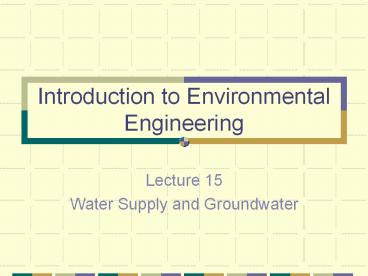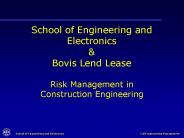Introduction to Environmental Engineering - PowerPoint PPT Presentation
1 / 13
Title:
Introduction to Environmental Engineering
Description:
... of 10-3 m/s, determine the concentration in the downstream well. ... Well concentration = Ct = Co e-kt = 100 mg/L e-(1x10-4days-1)(28,935 days) = 5.53 mg/L ... – PowerPoint PPT presentation
Number of Views:2176
Avg rating:3.0/5.0
Title: Introduction to Environmental Engineering
1
Introduction to Environmental Engineering
- Lecture 15
- Water Supply and Groundwater
2
Water
- Population Density
- The key to water is balance with the environment
- We arent in balance
- The natural environment will force Balance,
Equilibrium
3
Hydrologic Cycle
- Cycle of Water
- The basics that you already know
- Precipitation, percolation, runoff,
evapotranspiration, groundwater, surface water - Sources of Drinking water
- Groundwater and Surface Water
- Groundwater terms
- Zone of aeration, zone of saturation, water
table, aquifer, confined aquifer, artesian well
4
Groundwater supplies
- Often when groundwater is usually very little if
any treatment is performed before consumption. - Groundwater is polluted by point and non-point
sources just like surface waters. - A major difference in the pollution of
groundwater and the pollution of surface waters
is that groundwater is usually used by an
individual consumer that can not afford the
multiple barrier concept of treatment.
5
Multiple Barrier Concept
- 1. Effective Natural Barriers, Improve and
Protect Raw Water Quality, and Effective sewage
treatment upstream of the source - 2. Removal of Microbes Coagulation,
Flocculation, Sedimentation, Sand Filtration - 3. Inactivation of microbes by Chlorine
disinfection - Any one barrier is fallible, Full system is a
fail safe approach
6
Groundwater Flow
- Groundwater moves through different soils at
different rates based on the experimentally
determined coefficient of permeability, K - K as high as 10 m/s 1014 m/s
- Models are available for the subsurface that are
simple and complex - Very hard to predict because of the heterogeneity
of most aquifers
7
Porosity and Specific Yield
- The amount of water that can be stored in an
aquifer is equal to the volume of space between
the soil grains - Porosity
8
Specific Yield
- All water is not available for extraction
9
Darcys Law for Groundwater flow
10
Darcys Law
- Q flow (horizontal) through the aquifer, m3/s
- K coefficient of permeability, m/s
- A cross-sectional area, m2
- h2 h1 head drop, m
- l2 l1 length difference, m
11
Specific Discharge
- v Av/a Q/a
- v specific discharge, or flow per unit area,
m/s - If porosity is known pore velocity can be
calculated by - v/porosity actual water velocity
- To calculate time from point of pollution to a
down gradient point at a known distance. - This can be combined with a first or zero order
rate of decay.
12
Example
- If the water wells spaced at 5 km in a 20 m thick
confined aquifer are used to monitor groundwater
quality and the upstream well detects a pollutant
of concentration 100 mg/L. The head loss between
the two wells is 10 m/m. Assuming a decay
coefficient of k 10-4 day-1 and a coefficient
of permeability of 10-3 m/s, determine the
concentration in the downstream well.
13
Solution
- First calculate the velocity of the groundwater,
to determine how many days it will take to reach
the downstream well. - Gradient (head loss) 10 m/m
- K hydraulic conductivity 1 x 10-3 m/s
- k first order decay rate 1 x10-4 day-1
- V Darcy velocity K dh/dL 1 x 10-3 (10
m/5000m) 2 x 10-6 m/s - t x/v 5000m/2 x10-6 m/s 2.5 x109s x
1hr/3600s x 1 day/24 hr 28,935 days - Well concentration Ct Co e-kt 100 mg/L
e-(1x10-4days-1)(28,935 days) 5.53 mg/L































